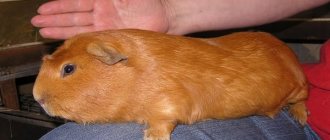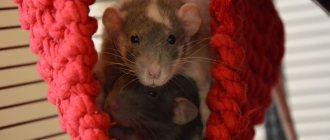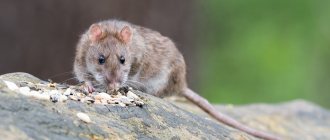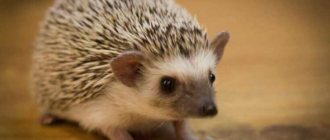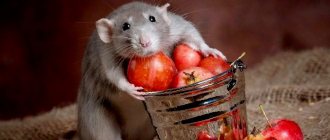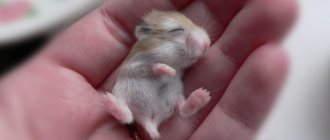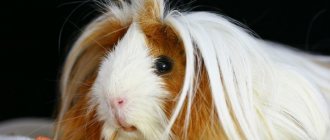Oddly enough, among all types of decorative rodents, domestic rats are becoming increasingly popular. These animals are very friendly, easy to care for, do not require much space to keep, and can always cheer you up. Moreover, it is believed that rats are very intelligent creatures, smart, cunning, and have a good memory.
There are a huge variety of rat breeds, which differ in size and type of fur. The main ones are presented in the photo below.
Varieties
There are several popular types and breeds of decorative rats:
- standard - a rat with smooth, glossy fur;
- Dambo - ears are larger than the others, rounded, low-set;
- satin - long wool, silky and shiny in appearance;
- sphinx - hair is completely absent;
- tailless - no tail;
- rex - much denser coat;
- double rex - hairless in some places, with rough fur in others;
- albino - a white decorative rat with red eyes.
Appearance
In appearance, the brunettes of the mouse family differ from their gray relatives, pasyuks, not only in their dark colors, but also in their smaller dimensions. The black rat has the following parameters:
- weight – up to 300 g;
- body length – up to 22 cm;
- tail length – up to 29 cm.
The length of the animal's tail always exceeds the length of the body.
The animal's muzzle is elongated, with expressive round beady eyes. Rat ears are similar to mouse ears:
- small size;
- round shape;
- wide at the base.
The coat of a black rat is divided into two layers:
- lower – undercoat;
- the top one is a long, hard pile.
The color is usually deep black with a green tint. But sometimes there are individuals with dark gray fur, almost like pasyuks. The richness of the color is associated with the region where the animal lives - the inhabitants of the north have a black fur coat, and the inhabitants of the south have a dark gray coat. On the sides, the fur is always several tones lighter than the main color.
The tail is scaly, completely covered with long dark hairs. The tip of the tail is decorated with a barely noticeable tassel.
Content Rules
Keeping decorative rats does not require any special wisdom. The main thing to do is to purchase a spacious cage.
Animals love to move, so they need space. The cage must be equipped:
- filler - the ideal option would be dry wood (it absorbs odors and liquids well);
- a house - a rat sometimes needs privacy;
- tunnels and ladders - pets will definitely want to play and run around;
- drinking bowl with fresh and clean water;
- a feeder well fixed to the rods;
- mineral stone so that animals can chew it.
It is strictly forbidden to use litter made from coniferous trees for decorative rats. It can cause serious illness and even death.
You can complement the design of the cage with various toys and treats for rodents.
Habitats
The favorite places of residence of rodents are ships and sea vessels. For them, these dwellings are ideal, since they combine the two main preferences of animals regarding housing - proximity to humans and water.
These animals try to settle close to people. Also, when choosing a place of residence, they give preference to areas near water bodies. But unlike pasyuks, brunette rats do not have a special attachment to water, so they often choose to settle in places such as:
- forests;
- edges;
- fields.
In an urban environment, the animal settles in the following places:
- abandoned buildings;
- trash cans;
- garages;
- entrances.
Also, dark rats settle in human houses, inhabiting the attic or upper tiers.
Feeding
Do you want to know what to feed your kitty rat? Everything is quite simple, especially since pets are unpretentious in food.
Note!
Domestic hedgehog - a review of the best hedgehog breeds to keep, all the features of the pet from feeding to living conditions! + photos and videos
- Domestic goat - an overview of the features of keeping goats, how to care for them and what to feed them, as well as diseases, treatment and prevention of diseases in the review!
Sheep - learn everything about keeping sheep, features of living conditions, diet and the main characteristics of sheep as a pet!
The rat menu should consist of:
Grain. Experienced owners prepare and select the ingredients for feeding themselves. A ready-made mixture of grains can be purchased at almost any pet store.
Vegetables, herbs and fruits. In small quantities. There is no need for any special products here; common vegetables and fruits are quite suitable for rats. Herbs such as dill and parsley will also suit their taste.
Protein food. A little meat, cottage cheese or cheese. These products are not for your daily diet.
List of foods that should not be given to rodents: sweets, legumes, cabbage, sausage, soda and chips. Make sure your pet does not eat indoor plants, as this may be life-threatening.
Where do the animals come from?
Fossil remains discovered by archaeologists indicate that the original habitats of black rodents were the Mediterranean and Middle Eastern territories. The animals managed to spread throughout the world thanks to their “love” for sea travel - they penetrated into remote territories from ships. In ancient times, black rodents were already found on almost all continents of the globe. The exploration of Russian lands by dark animals dates back to the beginning of the 17th century.
Subspecies
The black rodent family includes several species:
- Asian;
- oceanic;
- Mauritian;
- Ceylonese
They differ mainly in distribution. If individuals of the Asian subspecies live everywhere on the planet, then Ceylon ones are found exclusively on the island of Sri Lanka.
Photos of decorative rats
Life of rodents
They do not dig holes in the ground, but build nests in trees. A rat's building is similar to a magpie's nest. There are often cases when animals move into a ready-made nest, having first eaten its inhabitants.
Excellent climbing abilities allow black rats to move freely on both horizontal and vertical surfaces. The animals are able to climb to the very top of the tree, but they climb so high only when absolutely necessary.
During the day, black rats sit at home, hiding from sunlight, and under the cover of night they go in search of food. Caution is the key to any activity for a rodent. This is due to the large number of predatory enemies - animals with dark fur coats are eaten:
- birds;
- cats;
- dogs;
- hedgehogs;
- foxes;
- wolves.
The average lifespan of a wild rodent is 1-1.5 years. A decorative black rat kept as a pet can live for 4 years.
A little biology
Black rats are a species of mammal of the rodent order, the Latin name of the species is Rattus rattus.
The body length is 16-22cm. The weight of this type of rodent ranges from 100 to 350 grams. The tail is longer than the animal's body. Males are much larger in size than females. The color of a black rat can be of two types: 1) Close to black. Individual hairs have a greenish-metallic tint. The fur becomes lighter on the sides, and on the belly it becomes ashy or dirty gray. 2). Looks like a pasyuk, lighter and yellower. The abdomen has a white or yellowish tint. The black rat's muzzle is narrow, it has large ear shells, a well-formed neck, and a long, flexible tail. Basically, black rats are nocturnal animals, but the daily rhythm of their activity depends on the nature of human activity in the rooms where they live or get food. Rats are active primarily during those hours of the day when they are less bothered by the presence of people. The black rat's diet is varied. It eats grain, bread, various vegetables, and meat products, but unlike the gray rat, it prefers plant foods, and animal food is of relatively little importance to it, as a result of which its teeth, jaws and corresponding muscles are less developed than those of the gray rat. In nature, as a rule, it does not dig burrows, but lives in hollows or makes spherical nests from branches in trees, similar to the nests of magpies. It climbs very well, in nature it often leads a semi-arboreal lifestyle, but rarely swims. Like gray rats, black rats live in groups that include adults of both sexes and young animals. Hierarchical relationships are established within the group with dominance of one male. Two or three females usually dominate the rest of the group with the exception of the eldest male. Black rats are less aggressive than pasyuki; females are more aggressive than males. In case of danger, they try to hide from their pursuer and only, when caught, use their teeth.
Already a 3-4 month old black rat is capable of reproduction. Unlike the gray rat, it reproduces less intensively, although under favorable conditions it can bear offspring in winter. During the year there are usually 2-3 litters of 6-7 rats. The duration of pregnancy is 21-22 days. Newly born rat pups are completely naked, but they grow very quickly, become covered with hair and become able to independently obtain food. In the wild, life expectancy rarely exceeds 2 years. In captivity, a black rat with careful care can live up to 5-6 years.
Danger and damage to humans
Rodent pests - both black and gray - pose an equal threat to humans. Rodents are:
- spreaders of diseases;
- carriers of bacteria, microorganisms, parasites, etc.
In addition, the negative results of rat visits include damage and destruction:
- food supplies;
- harvest;
- trees;
- plants.
Rats are able to penetrate any building, premises, storage facilities, etc. No building materials stop them - the animals gnaw through any walls and ceilings. When a rodent gets into a house, it spoils not only food, but also furniture, interior items, etc. In this barbaric way, rats grind down their continuously growing teeth.
Diet
A black rat can hardly be called a predator. The animal mainly feeds on food of plant origin:
- grain;
- seeds;
- vegetables;
- fruits.
The proportion of protein in a rodent's diet is very small. Only occasionally does the rat diet include:
- beetles;
- worms;
- bird eggs.
The animal is not known for its gluttony - during the day it consumes:
- 15 g food;
- 15 ml water.
But starvation is practically unacceptable for a rat. The animal can live without food for a maximum of 2 weeks, and without water (or if there is a lack of it) - only a week.
Baby rats
Newborn black rat cubs are characterized by the following:
- complete absence of fur;
- blindness;
- deafness;
- underdevelopment of the limbs.
With all this, kids have an excellent appetite. Every day, the pups noticeably change physically:
- after a week of birth, they start to have fluff;
- after 2 weeks they begin to see and hear;
- after 3 weeks, their skeleton and limbs are fully formed, after which the babies crawl out of the nest.
Month-old baby rats are already absolutely independent - they eat “adult” food, etc. Parents kick their offspring out of their nest, and the grown-up individuals begin an independent life, becoming full-fledged members of the rat colony to which their parents belong. In young females, puberty is completed by six months, after which they are ready to have their own offspring.
Ways to fight
You can fight rat infestations using various methods. Garden trees should be wrapped with belts and lubricated with glue or resin. Traps and traps can be installed on the site. You can also set traps inside the house and place various poisoned baits. To scare away animals, you can use both special devices and strong-smelling herbs. In the event of a mass raid, infection of the premises, etc., you should immediately call specialists.
Sources
- https://fishki.net/3186865-chernaja-krysa-i-interesnye-fakty-o-nej.html
- https://homjakam.ru/krysa/raznovidnosti/chernye-krysy
- https://notklop.ru/krysy/vidy-krys/chernye-krysy/
- https://apest.ru/krysy/vidy-krys/chernye-krysy/
- https://animals-wild.ru/mlekopitayushhie-zhivotnye/1247-chernaya-krysa.html
- https://litbro.ru/gryzuny/krysa/kak-uhazhivat-za-chernoj-krysoj
[collapse]
Types of breeds
First of all, it is worth understanding that each breed has its own individual characteristics. Animals of different breeds have different builds, sizes, fur and colors.
So, let's look at how they are distinguished:
- By body type. Dumbo and standard.
- By type of wool. Standard, hairless, wavy, downy, rex.
- By color. Single-color, combined, three-color, mosaic, silver, husky.
- Marking. The color base is predominantly white.
Relationships in a rat family
Black rats live in colonies of several hundred individuals each. The colony is headed by one male and several females. The youngsters learn from the experience of the “oldies.” Young females help adult mothers raise their cubs. In one nest, the offspring of several females are raised and fed.
Males often conflict for a variety of reasons, the main ones being females and food. The defeated individual avoids its winner.
Each rat family owns a territory of about 2.5 square meters.
Natural enemies
In the wild, black rats are constantly in danger and have to flee from predators. Foxes, wolves, hedgehogs, dogs, cats, and large birds love to prey on rodents.
Since time immemorial, people have been waging war against wild rodents in order to limit their numbers. Special measures to kill rats are called deratization.
Taking into account the fact that the meat of black rats is a component of some national dishes, there is a targeted hunt for these rodents in tropical countries. Their populations are noticeably declining after fires and indiscriminate deforestation.
The natural enemy of domesticated animals is sometimes humans. If, intentionally or unknowingly, the owners of a black rat treat their pet poorly and do not feed it enough, the animal will experience stress and may even attempt to escape.
For your information! Wild rats sometimes fight each other, and cannibalism is common among them.
